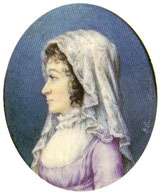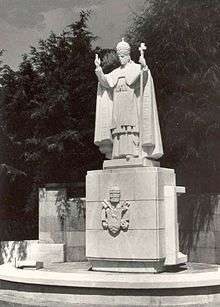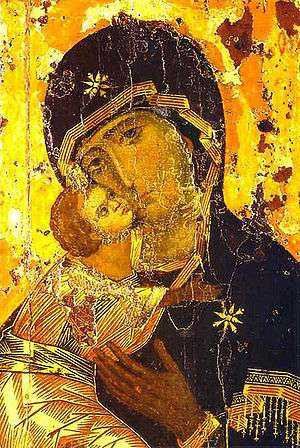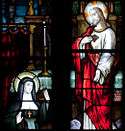Immaculate Heart of Mary
| The Immaculate Heart of Mary | |
|---|---|
|
| |
| Venerated in | Roman Catholic Church |
| Feast | Saturday following the Feast of the Sacred Heart |
| Attributes | Burning bloodied heart, pierced with a sword, banded with roses,and lily flowers |
| Patronage | Alliance of Sacred Hearts, Russian Territories, Central Africa, Republic of the Congo, Angola, Ecuador, Panama, Philippines, Georgia |
The Immaculate Heart of Mary is a devotional name used to refer to the interior life of the Blessed Virgin Mary, her joys and sorrows, her virtues and hidden perfections, and, above all, her virginal love for God the Father, her maternal love for her son Jesus, and her compassionate love for all people.[1]
The Eastern Catholic Churches occasionally utilize the image, devotion, and theology associated with the Immaculate Heart of Mary. However, this is a cause of some controversy, some seeing it as a form of liturgical latinisation. The Roman Catholic view is based on Mariology, as exemplified by Pope John Paul II's Apostolic Letter Rosarium Virginis Mariae.[2]
Traditionally, the heart is depicted pierced with seven wounds or swords, in homage to the seven dolors of Mary. Also, roses or another type of flower may be wrapped around the heart.
Veneration
| A series of articles on the |
| Sacred Heart of Jesus |
|---|
 |
| Devotions |
| People |
| Encyclicals |
| Churches |
|
|
Veneration of the Heart of Mary is analogous to worship of the Sacred Heart of Jesus. There are, however, differences in this analogy as devotion to the heart of Jesus is especially directed to the "divine heart" as overflowing with love for humanity. In the devotion to Mary, however, the attraction is the love of her heart for Jesus and for God.[1]
A second difference is the nature of the devotion itself. In devotion to the Sacred Heart of Jesus, the Roman Catholic venerates in a sense of love responding to love. In devotion to the Heart of Mary, study and imitation hold as important a place as love.[1] The aim of the devotion is to unite mankind to God through Mary's heart, and this process involves the ideas of consecration and reparation.[3] The object of the devotion being to love God and Jesus better by uniting one's self to Mary for this purpose and by imitating her virtues.
History of devotion
Scriptural basis
In Chapter 2 of St. Luke's gospel, the evangelist twice reports that Mary kept all things in her heart, that there she might ponder over them.[4] Luke 2:35 recounts the prophecy of Simeon that her heart would be pierced with a sword. This image (the pierced heart) is the most popular representation of the Immaculate Heart.[1]
St. John's Gospel further invited attention to Mary's heart with its depiction of Mary at the foot of the cross at Jesus' crucifixion. St. Augustine said of this that Mary was not merely passive at the foot of the cross; "she cooperated through charity in the work of our redemption".[1]
St. Leo said that through faith and love she conceived her son spiritually, even before receiving him into her womb,[4] and St. Augustine tells us that she was more blessed in having borne Christ in her heart than in having conceived him in the flesh.
Various saints

Devotion to the Heart of Mary began in the Middle Ages with saints like Anselm of Canterbury, and Bernard of Clairvaux. It was practiced and developed by Mechtild, Gertrude the Great and Bridget of Sweden.[5] Evidence is also discernible in the pious meditations on the Ave Maria and the Salve Regina, usually attributed either to St. Anselm of Lucca (d. 1080) or St. Bernard; and also in the large book "De laudibus B. Mariae Virginis" (Douai, 1625) by Richard de Saint-Laurent, Penitentiary of Rouen in the thirteenth century.
A little earlier it had been included by St. Thomas Becket in the devotion to the joys and sorrows of Mary, by St. Hermann (d.1241) in his devotions to Mary, and somewhat later it appeared in Bridget of Sweden's "Book of Revelations". St. Bernardine of Siena (d.1444), is sometimes called “Doctor of the Heart of Mary”,[5] and it is from him that the Church has borrowed the lessons of the second nocturn for the feast of the Heart of Mary. St. Francis de Sales speaks of the perfections of this heart, the model of love for God, and dedicated to it his "Theotimus."
During this same period one finds occasional mention of devotional practices to the Heart of Mary, e.g., in the "Antidotarium" of Nicolas du Saussay (d. 1488),[6] in Pope Julius II, and in the "Pharetra" of Lanspergius. In the second half of the sixteenth century and the first half of the seventeenth, ascetic authors dwelt upon this devotion at greater length.
It was, however, St. John Eudes (d. 1681) who propagated the devotion, to make it public, and to have a feast celebrated in honor of the Heart of Mary, first at Autun in 1648 and afterwards in a number of French dioceses. He established several religious societies interested in upholding and promoting the devotion, of which his large book on the Coeur Admirable (Admirable Heart), published in 1681, resembles a summary. Jean Eudes' efforts to secure the approval of an office and feast failed at Rome, but, notwithstanding this disappointment, the devotion to the Heart of Mary progressed. In 1699 Father Pinamonti (d. 1703) published in Italian a short work on the Holy Heart of Mary, and in 1725, Joseph de Gallifet combined the cause of the Heart of Mary with that of the Heart of Jesus in order to obtain Rome's approbation of the two devotions and the institution of the two feasts. In 1729, his project was defeated, and in 1765, the two causes were separated, to assure the success of the principal one.
Feast day
In its principal object this feast is identical with the feast of the "Inner Life of Mary", celebrated by the Sulpicians on 19 October. It commemorates the joys and sorrows of the Mother of God, her virtues and perfections, her love for God and her Divine Son and her compassionate love for mankind.[7]
As early as 1643, St. John Eudes and his followers observed 8 February as the feast of the Heart of Mary.[4] In 1799 Pius VI, then in captivity at Florence, granted the Bishop of Palermo the feast of the Most Pure Heart of Mary for some of the churches in his diocese. In 1805 Pope Pius VII made a new concession, thanks to which the feast was soon widely observed. Such was the existing condition when a twofold movement, started in Paris, gave fresh impetus to the devotion. The two factors of this movement were, first of all, the revelation of the "Miraculous Medal" in 1830, and then the establishment at Notre-Dame-des-Victoires of the Archconfraternity of the Immaculate Heart of Mary, Refuge of Sinners, which spread rapidly. On 21 July 1855, the Congregation of Rites finally approved the Office and Mass of the Most Pure Heart of Mary without, however, imposing them upon the Universal Church.
Pope Pius XII instituted the feast of the Immaculate Heart of Mary in 1944 to be celebrated on 22 August,[8] coinciding with the traditional octave day of the Assumption.[9] In 1969, Pope Paul VI moved the celebration of the Immaculate Heart of Mary to the day, Saturday, immediately after the Solemnity of the Sacred Heart of Jesus. This means in practice that it is now held on the third Saturday after Pentecost.[10]
At the same time as he closely associated the celebrations of the Immaculate Heart of Mary and the Sacred Heart of Jesus, Pope Paul VI moved the celebration of the Queenship of Mary from 31 May to 22 August, bringing it into association with the feast of her Assumption. Those who use the 1962 edition of the Roman Missal or an earlier one (but not more than 17 years before 1962) observe the day established by Pius XII.
It is kept as the patronal feast of the Republic of Ecuador, of the Congregation of the Holy Ghost, of the Society of the Sacred Hearts of Jesus and Mary, and of the Missionary Society of the Heart of Mary.[7]
Related devotions
Seven Dolors
Traditional depictions of the IHM show it pierced with seven wounds or swords, in homage to the seven dolors of Mary. The Seven Sorrows of Mary are a popular Roman Catholic devotion. There are devotional prayers which consist of meditation on her Seven Sorrows. One practice is to pray seven Hail Marys daily. The term "Sorrowful and Immaculate Heart of Mary" refers to the combined devotion of both the Immaculate Heart and the Seven Sorrows of Mary as first used by the Franciscan Tertiary Berthe Petit.
Miraculous Medal

Devotion to Mary's Heart has had a greater flowering following the manifestation of the Miraculous Medal to St. Catherine Labouré in 1830.[4] The Immaculate Heart is depicted on the Miraculous Medal,[11] pierced by a sword. The Sacred Heart of Jesus also appears on the medal, next to the Immaculate Heart, crowned with thorns. The M on the medal signifies the Blessed Virgin at the foot of the Cross when Jesus was being crucified.
Five First Saturdays
Our Lady of Fátima asked that, in reparation for sins committed against her Immaculate Heart, on the first Saturday of five consecutive months a Catholic go to Confession (within eight days before or after the first Saturday), receive Holy Communion, recite five decades of the Rosary, and keep her company for 15 minutes while meditating on the 15 mysteries of the Rosary. She promised that, whoever would ever do this, would be given at the hour of his death the graces necessary for salvation.[12]
Alliance with the Sacred Heart

The Alliance of the Hearts of Jesus and Mary is based on the historical, theological and spiritual links in Catholic devotions to the Sacred Heart of Jesus and the Immaculate Heart of Mary.[13][14][15] The joint devotion to the hearts was first formalized in the 17th century by St. John Eudes who organized the scriptural, theological and liturgical sources relating to the devotions and obtained the approbation of the Church, prior to the visions of St. Margaret Mary Alacoque.[16][17][18]
In the 18th and 19th centuries the devotions grew, both jointly and individually through the efforts of figures such as St. Louis de Montfort who promoted Catholic Mariology and St. Catherine Labouré's Miraculous Medal depicting the Heart of Jesus thorn-crowned and the Heart of Mary pierced with a sword.[19][20][21] The devotions, and the associated prayers, continued into the 20th century, e.g., in the Immaculata prayer of St. Maximillian Kolbe and in the reported messages of Our Lady of Fátima which stated that the Heart of Jesus wishes to be honored together with the Heart of Mary.[22][23]
Popes supported the individual and joint devotions to the hearts through the centuries. In the 1956 encyclical Haurietis aquas, Pope Pius XII encouraged the joint devotion to the hearts. In the 1979 encyclical Redemptor hominis, Pope John Paul II explained the theme of unity of Mary's Immaculate Heart with the Sacred Heart.[24] In his Angelus address on 15 September 1985 he coined the term The Alliance of the Hearts of Jesus and Mary, and in 1986 addressed the international conference on that topic held at Fátima, Portugal.[25][26][27][28]
Acts of Consecration


During the third apparition at Fátima, Portugal, on 13 July 1917, the Our Lady allegedly said that to the three little shepherds "God wishes to establish in the world devotion to her Immaculate Heart" in order to save souls from hell and to bring about world peace, and also asked for the consecration of Russia to her Immaculate Heart. Pope Pius XII, in his Apostolic Letter of 7 July 1952 Sacro Vergente, consecrated Russia to the Most Blessed Virgin Mary.
Also, Blessed Alexandrina of Balazar, in Portugal, reported many private apparitions, messages and prophecies received directly from Jesus and the Blessed Virgin Mary. In June 1938, based on the request of her spiritual director Father Mariano Pinho, several bishops from Portugal wrote to Pope Pius XI, asking him to consecrate the world to the Immaculate Heart of Mary. At that time Cardinal Eugenio Pacelli (later Pope Pius XII) was the secretary of the state of the Vatican, and he later performed the consecration of the world.[29]
On 25 March 1984 Pope John Paul II fulfilled this request again, when he made the solemn act of consecration of the world, and implicitly Russia, to the Immaculate Heart of Mary before the miraculous statue of Our Lady of Fátima brought to Saint Peter's Square in the Vatican for the occasion. Sister Lúcia, OCD, then the only surviving visionary of Fátima apparitions, confirmed that the request of Mary for the consecration of Russia to the Immaculate Heart of Mary was accepted by Heaven, and therefore, was fulfilled. Again on 8 October 2000, the same pope made an act of entrustment of the world to the Immaculate Heart of Mary for the new millennium.[30]
In August 2013, Pope Francis announced that he would consecrate the world to the Immaculate Heart of Mary on 13 October 2013, as part of the Marian Day celebration that involved the iconic statue of Our Lady of the Rosary of Fátima.[31]
See also
- Blessed Virgin Mary (Roman Catholic)
- Consecration and entrustment to Mary
- Immaculate Mary
- Sacred Heart of Jesus
- Sisters, Servants of the Immaculate Heart of Mary
- Sorrowful and Immaculate Heart of Mary
References
Notes
- 1 2 3 4 5 Bainvel, Jean. "Devotion to the Immaculate Heart of Mary". The Catholic Encyclopedia. Vol. 7. New York: Robert Appleton Company, 1910. 20 December 2012
- ↑ Pope John Paul II's Apostolic Letter Rosarium Virginis Mariae
- ↑ "The Immaculate Heart of Mary", Catholic News Agency
- 1 2 3 4 Mauriello, Rev. Matthew R., "Devotion to the Immaculate Heart of Mary", University of Dayton
- 1 2 Roten, Johan G. "The Heart of Mary", Marian Library, University of Dayton, June 4, 2013
- ↑ Murphy, John F., Mary's Immaculate Heart, The Bruce Publishing Company, Milwaukee, 1951
- 1 2 Holweck, Frederick. "Feast of the Most Pure Heart of Mary." The Catholic Encyclopedia. Vol. 10. New York: Robert Appleton Company, 1911. 10 March 2015
- ↑ Calendarium Romanum (Libreria Editrice Vaticana, 1969), p. 94
- ↑ Compare 22 August in the Tridentine Calendar with the same date on the General Roman Calendar as in 1954
- ↑ Calendarium Romanum (Libreria Editrice Vaticana, 1969), pp. 94, 135
- ↑ Glass, Joseph. "Miraculous Medal." The Catholic Encyclopedia. Vol. 10. New York: Robert Appleton Company, 1911. 20 December 2012
- ↑ First Saturday Devotion to the Immaculate Heart of Mary Archived May 15, 2011, at the Wayback Machine.
- ↑ Mary's Immaculate Heart by John F. Murphy 2007 ISBN 1-4067-3409-8 pages 59-60
- ↑ Heart of the Redeemer by Timothy Terrance O'Donnell, 1992 ISBN 0-89870-396-4 page 272
- ↑ Arthur Calkins, The Theology of the Alliance of the Two Hearts, Missio Immaculatae (English Edition) Year III, N° 4 (May to December 2007).
- ↑ Roman Catholic worship: Trent to today by James F. White 2003 ISBN 0-8146-6194-7 page 34
- ↑ From Trent to Vatican II: historical and theological investigations by Raymond F. Bulman, Frederick J. Parrella 2006 ISBN 0-19-517807-6 page 182
- ↑ Praying with the saints by Woodeene Koenig-Bricker 2001 ISBN 0-8294-1755-9 page 134
- ↑ In Prayer With Mary the Mother of Jesus by Jean Lafrance 1988 ISBN 2-89039-183-3 page 310
- ↑ Companion to the Calendar: A Guide to the Saints and Mysteries by Mary Ellen Hynes 2007 ISBN 1-56854-011-6 page 24
- ↑ Butler's lives of the saints, Volume 12 by Alban Butler, Kathleen Jones, 2000 ISBN 0-86012-261-1 page 245
- ↑ Youngest Prophet by Christopher Rengers 1998 ISBN 0-85342-815-8 page 38
- ↑ The children of Fatima: Blessed Francisco & Blessed Jacinta Marto by Leo Madigan 2003 OSV Press ISBN 1-931709-57-2 page 248
- ↑ Peter Stravinskas, 2002, Catholic Dictionary, OSV Press ISBN 978-0-87973-390-2 page 485
- ↑ Pope John Paul II 1986 Speech at the Vatican Website
- ↑ Arthur Calkins, The Alliance of the Two Hearts and Consecration, Miles Immaculatae XXXI (July/December 1995) 389-407.
- ↑ Proceedings of the International Theological Symposium on the Alliance of the Hearts of Jesus and Mary, September 1986, Fátima, Portugal
- ↑ Vatican website: Pope John Paul II Angelus address of September 15, 1985 (Spanish and Italian)
- ↑ Calkins, Arthur Burton. Totus tuus: John Paul II's program of Marian consecration and entrustment, 1992, ISBN 0-9635345-0-5 page 97
- ↑ Pope John Paul II, Jubilee of Bishops, Rome, October 8, 2000, http://www.vatican.va/holy_father/john_paul_ii/homilies/2000/documents/hf_jp-ii_hom_20001008_act-entrustment-mary_en.html ; retrieved June 13, 2012
- ↑ Catholic News Agency - Pope Francis will consecrate the world to the Immaculate Heart of Mary
External links
| Wikimedia Commons has media related to Immaculate Heart of Mary. |



